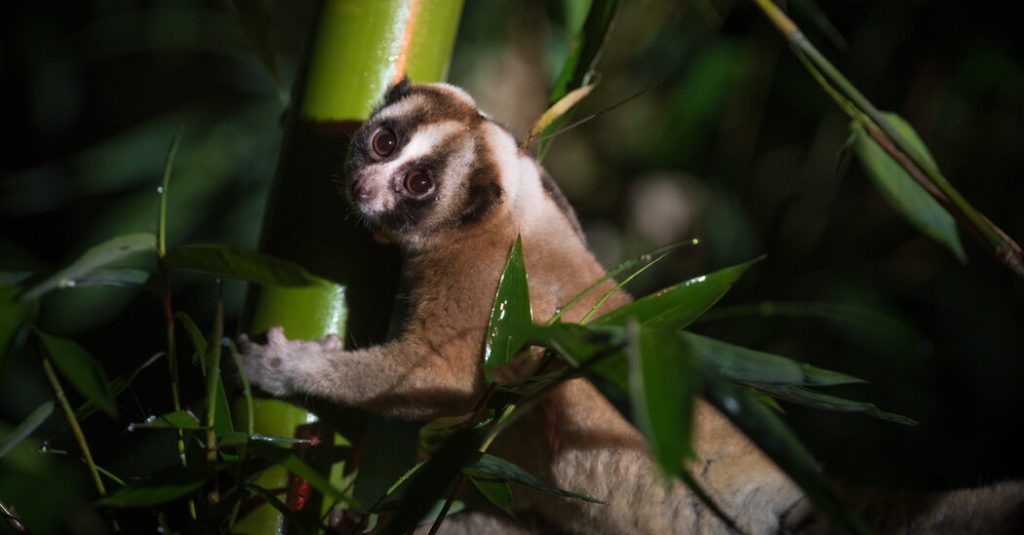Slow Lorises Bite With Flesh-Rotting Venom
4 min read
With their bright saucer eyes, button noses and plump, fuzzy bodies, sluggish lorises — a group of tiny, nocturnal Asian primates — resemble lovable, dwelling stuffed animals. But their innocuous appears to be like belie a startling aggression: They pack vicious bites loaded with flesh-rotting venom. Even much more surprising, new research reveals that the most recurrent recipients of their toxic bites are other slow lorises.
“This incredibly unusual, odd habits is happening in a person of our closest primate kinfolk,” reported Anna Nekaris, a primate conservationist at Oxford Brookes College and lead author of the findings, released Monday in Latest Biology. “If the killer bunnies on Monty Python ended up a true animal, they would be sluggish lorises — but they would be attacking every other.”
Even right before this new discovery, sluggish lorises presently stood out as an evolutionary oddity. Researchers know of just five other forms of venomous mammals: vampire bats, two species of shrew, platypuses and solenodons (an insectivorous mammal discovered in Cuba, the Dominican Republic and Haiti).
Researchers are just beginning to untangle the a lot of mysteries of gradual loris venom. 1 important part resembles the protein found in cat dander that triggers allergy symptoms in human beings. But other unknown compounds seem to lend supplemental toxicity and result in serious soreness. Unusually, to create the venom, the melon-sized primates raise their arms over their head and rapidly lick venomous oil-secreting glands located on their higher arms. The venom then pools in their grooved canines, which are sharp sufficient to slice into bone.
“The consequence of their chunk is definitely, truly horrendous,” Dr. Nekaris says. “It brings about necrosis, so animals may perhaps drop an eye, a scalp or half their face.”
Ahead of this review, quite a few nonetheless debated the primary goal of sluggish loris venom. Capturing prey was ruled out due to the fact tree gum is their key food items. That built defense against predators or parasites into foremost hypotheses. But anecdotal evidence has also hinted for many years that gradual lorises may use their venom towards their very own.
For case in point, sluggish lorises are preferred in the illegal pet trade. Illegal pet traders in Indonesia advised Dr. Nekaris that they take away the animals’ tooth not to protect long term owners, but to avoid gradual lorises from harming each and every other and ruining their value. Poachers interviewed by her also complained of occasionally capturing “ugly” slow lorises with extensive scarring or gaping wounds that they had to permit go for the reason that no pet customer would want them.
Additionally, zoo and rescue facility workers report that just one of the most frequent triggers of loss of life for gradual lorises is bites from other gradual lorises.
To get to the bottom of how sluggish lorises use their venom in character, Dr. Nekaris used radio collars to monitor 82 Javan sluggish lorises, a critically endangered species in Indonesia. Like other styles of sluggish lorises, Javan slow lorises sort long-phrase mating pairs that occupy modest territories containing 1 or quite a few gum-generating trees.
Over an 8-12 months span, the researchers invested more than 7,000 several hours checking their analyze topics in a two-square mile patch of forest. They recaptured the animals each and every handful of months for overall health checks.
Shockingly, across all captures, 20 % of slow lorises had contemporary bite wounds — oftentimes severe, flesh-rotting injuries that entailed a lost ear, toe or additional. Males suffered extra regular bites than ladies, as did young animals dispersing from their parents’ territories. Although necrotic wounds were a common occurrence, predation was not because 2012, the scientists have missing just a single Javan sluggish loris to a predator, which was a feral pet dog.
Dr. Nekaris and her colleagues concluded that gradual lorises are remarkably territorial, and that they commonly use their venom to settle disputes. This puts them among the just a handful of other species identified to use venom for this purpose, which include cone snails, ghost shrimp and male platypuses.
The findings signify “a really neat addition to our know-how,” mentioned Kevin Arbuckle, an evolutionary biologist at Swansea University, who was not associated in the new review.
The paper also lends one of a kind insight into how people of the similar species could use venom on one particular another to contend for confined means these as mates or territory — some thing that few research have examined, stated Ronald Jenner, a venom professional at the Purely natural Heritage Museum in London, who also was not concerned in the study. “To my knowledge, this is the most intensive subject study ever accomplished on this topic.”



